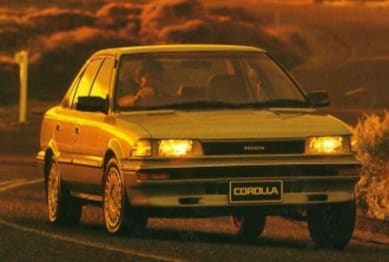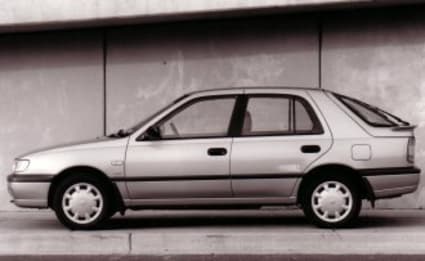
Used Toyota Corolla review: 1991-1994
- Toyota Corolla
- Toyota Corolla 1991
- Toyota Corolla 1992
- Toyota Corolla 1993
- Toyota Corolla 1994
- Toyota Corolla Reviews
- Toyota Reviews
- Toyota Hatchback Range
- Hatchback
- Toyota
- Used Car Reviews
- Buying tips

The mere mention of the name Corolla conjures up an image of a well-built, reliable and accomplished small car. There is no better example of what the Corolla is about than the AE92 model Toyota unveiled in 1991.
The Corolla first arrived here in the late 1960s when small cars wore badges like Morris, Austin and Vauxhall, but while others have long disappeared from local showrooms, the baby Toyota has become the small car benchmark.
The sixth generation AE92 Corolla was just such a car, well engineered, well built, and well equipped, and while it’s now nearing the end of its useful life those attributes still make it a good choice for anyone with a limited budget, like those hitting the road for the first time.
In the course of the last 40 years the Corolla has grown in size and has moved up a rung in the marketplace. Where it was an entry-level car at launch it has been replaced in that role by the cheap and cheerful Korean cars that have taken over the Corolla’s role in recent years.
The Corolla is now a family car for young couples new to the nesting game, it’s also in demand for those at the other end of life who’ve bade farewell to their offspring and want to downsize.
When the new Corolla was unveiled in 1991 the Korean tidal wave was yet to land on our shores in the way it would just a few years later, so the small Toyota was still one of the rulers in the small segment.
MODEL WATCH
Anyone who cared to count would find a staggering 21 models in the Corolla in 1991. Toyota clearly wanted to have a model for everyone, from the budget conscious buyer who was happy to have basic transport to those who wanted a little more comfort in their ride, and on to those wanting a thrill-a-minute from their motoring.
With four bodies to choose from, sedan, hatch, liftback and wagon, plus three levels of equipment, SE, CS and CS-X, four engines and three transmissions there was a car for everyone.
At first glance there seems little difference between the AE92 and its predecessor, but a closer look would reveal the Toyota corporate logo on the grille in place of the Toyota name, and the edges were smoothed and rounded making for a softer shape overall.
The four-door sedan was a pleasant looking car if rather conservative, and aimed squarely at families and older folk. The five-door hatch was smarter with plenty of appeal for younger drivers with its cute lines and rounded tail, while the five-door liftback was the most attractive with its longer, smoother tail. There was also a wagon for the most space.
The sedan was available in SE, CS and CS-X levels, likewise the hatch, which also boasted a sporty SX, while the Seca liftback was offered in CS, CS-X and SX variants.
All of the engines featured twin overhead camshafts with four valves per cylinder, but not all were fuel-injected at the time of launch.
The entry engine was the 60 kW 1.4-litre narrow twin cam, which was fitted with a carburettor and was unique to the Australian market. It was available in the SE sedan and SE and CS hatch, and only with a five-speed manual transmission. Despite its small size it was quite lively, but it was also had a flexible nature which made for smooth unfussed motoring.
Toyota also offered a 67 kW 1.6-litre version of the engine, again with a carburettor, which was standard on all CS and CS-X models, and the SE hatch. The five-speed manual was the standard gearbox, but there was a three-speed auto offered as an option on all CS models, and the SE hatch. There was also a four-speed auto, but that was only available at the CS-X level.
The wagons had an imported 1.6-litre narrow twin cam engine, which was fuel-injected and delivered 76 kW, but it was the sporty wide twin cam 1.6-litre that got everyone’s attention.
That was the 4A-GE engine that boasted fuel-injection along with a sporty cylinder head among a raft of upgrades that combined to produce a powerful peak of 100 kW. In its day it was one of the world’s top performing naturally aspirated engines, no wonder many specialist sports car makers around the world adopted it.
Companies like Elfin, Caterham, Westfield and many others who appreciated its performance and packaging have used it. Even today the 4E-GE engine is talked about in reverent tones.
Suspension was a combination of MacPherson Strut front and strut rear, same as the previous model, but there was a long list of detail changes that improved the steering feel and handling.
Brakes were disc front and drum rear on the base models, but higher models also got disc rears.
Steering was rack and pinion without power assistance, but power steering was available as an option.
Inside the new Corolla had revised seats offering greater comfort, and a new instrument panel and fascia. All but the base model had a split/fold rear seat, and the upper models also had a fold-up rear seat cushion.
At the time of the Corollas release Toyota was involved in the ultimately unsuccessful partnership with Holden that saw Holden release a rebadged Corolla called the Nova.
IN THE SHOP
There’s no doubting the Corolla’s build quality, it was of a level that others could only aspire to. The reality, though, is that it now has up to 12 years under the tyres and that means there’ll be plenty of kays showing on its odometer, and no car can escape the ravages of time and kays completely.
It’s important to check any Corolla thoroughly before handing over any money. Take your time when looking for a car and seek advice from an expert in the field for added comfort.
Although cars as old as the Corolla is now rarely have complete service records, it’s worth asking the vendor for one to get an idea of how the car has been treated.
When inspecting the car look for signs of home maintenance as many of these older Corollas are now at the time of their lives where they are being neglected by owners who can’t afford to service them or don’t care.
If looked after the Corolla will provide reliable service for some years to come. The engines are reliable if looked after, but will have done the sort of mileage that will require a second cam belt change.
Gearboxes are generally troublefree, but the five-speed gearbox is prone to breaking fifth gear. If it jumps out of fifth gear on a road test then walk away.
Drivelines tend to stand up well, but look carefully at the rubber boots protecting the drive shaft joints, looking particularly for splits, which might expose the joint to dirt and grime from the road and hasten their demise.
Body work stands up well, but local paint can be a problem with metallic colours fading. Interior trim holds up well, but look for heavy wear on the seats.
OWNER’S VIEW
Justin Cook bought his 1.4-litre Holden Nova new in March '91, and has since covered 285,000 mostly trouble free kilometres. He has had to replace a water pump at 60,000 km, and the alternator bushes, but apart from that he says it has not missed a beat. He expects to replace the original radiator and exhaust soon, but expects to get many more years out of the Nova before it dies. In summary he says he cannot imagine any other car giving such economical motoring, in terms of initial purchase, fuel and maintenance costs.
LOOK FOR
• high mileage means greater chance of problems so be careful when choosing a car
• robust engines generally reliable, but look for signs of neglect
• solid body structure holds up well
• great handling from responsive chassis
• pound for pound performer without peer
• Jumping out of fifth gear indicates gearbox woes
Pricing
| Year | Price From | Price To |
|---|---|---|
| 1994 | $1,980 | $4,070 |
| 1993 | $1,980 | $4,070 |
| 1992 | $1,380 | $4,070 |
| 1991 | $1,380 | $4,070 |
Pricing guides
Range and Specs
| Vehicle | Specs | Price* | |
|---|---|---|---|
| CS Seca | 1.6L, ULP, 5 SP MAN | $1,980 – 3,080 | 1991 Toyota Corolla 1991 CS Seca Pricing and Specs |
| CS | 1.6L, ULP, 5 SP MAN | $1,980 – 3,080 | 1991 Toyota Corolla 1991 CS Pricing and Specs |
| SE | 1.6L, ULP, 5 SP MAN | $1,980 – 3,080 | 1991 Toyota Corolla 1991 SE Pricing and Specs |
| CS-X | 1.6L, ULP, 5 SP MAN | $1,980 – 3,080 | 1991 Toyota Corolla 1991 CS-X Pricing and Specs |
Other cars to consider
$1,980
Lowest price, based on third party pricing data











